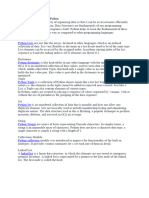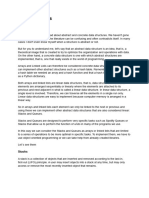0% found this document useful (0 votes)
2 views3 pagesData Structures Explanation
The document provides a comprehensive overview of various data structures including arrays, strings, linked lists, stacks, queues, and binary trees, along with Python examples for each. It explains the characteristics and functionalities of these structures, such as the immutability of strings and the LIFO and FIFO principles of stacks and queues. Additionally, it includes code snippets demonstrating operations like finding the maximum element in an array, reversing a string, implementing a linked list, and performing an inorder traversal of a binary tree.
Uploaded by
shanmugapriya5222422Copyright
© © All Rights Reserved
We take content rights seriously. If you suspect this is your content, claim it here.
Available Formats
Download as DOCX, PDF, TXT or read online on Scribd
0% found this document useful (0 votes)
2 views3 pagesData Structures Explanation
The document provides a comprehensive overview of various data structures including arrays, strings, linked lists, stacks, queues, and binary trees, along with Python examples for each. It explains the characteristics and functionalities of these structures, such as the immutability of strings and the LIFO and FIFO principles of stacks and queues. Additionally, it includes code snippets demonstrating operations like finding the maximum element in an array, reversing a string, implementing a linked list, and performing an inorder traversal of a binary tree.
Uploaded by
shanmugapriya5222422Copyright
© © All Rights Reserved
We take content rights seriously. If you suspect this is your content, claim it here.
Available Formats
Download as DOCX, PDF, TXT or read online on Scribd
/ 3
























































